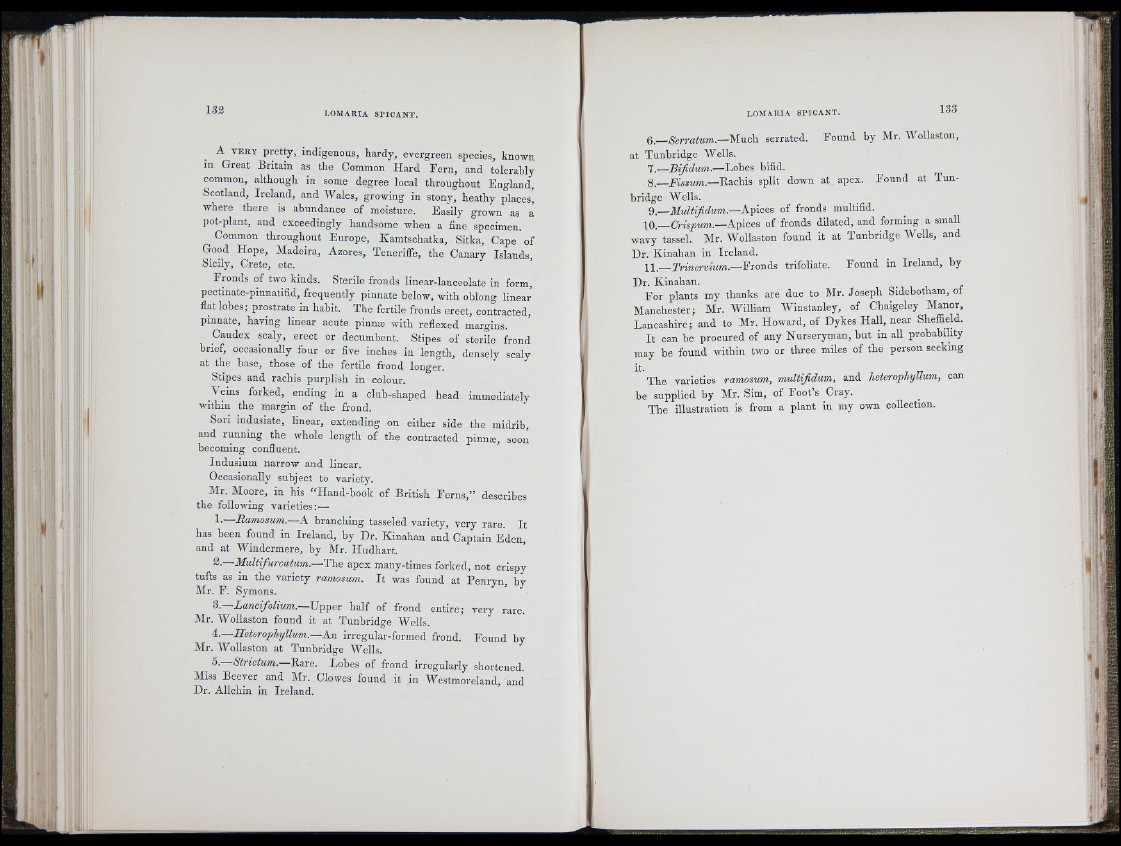
132 LOMARIA SPICANT.
A VERY p re tty , indigenous, h a rd y , ev ergreen species, known
in G re a t B rita in as th e Common H a rd F e rn , and tolerably
common, although in some d egree local th ro u g h o u t E n g la n d ,
Scotland, Ire la n d , and Wales, growing in stony, he a th y places,
■where th e re is abundance of moisture. E a sily grown as a
p o t-plant, and exceedingly handsome when a fine specimen.
Common th ro u g h o u t E u ro p e , Kamtschatka, Sitka, Cape of
Good H o p e , Madeira, Azores, Teneriffe, the Canary Islands,
Sicily, Cre te , etc.
F ro n d s of two kinds. Sterile fronds linear-lanceolate in form,
pectinate-pinnatifid, freq u en tly pinnate below, with oblong linear
flat lobes; prostrate in habit. T h e fertile fronds erect, contracted,
p innate, hav in g linear acute pinnæ with reflexed margins.
Caudex scaly, erect or decumbent. Stipes of sterile frond
brief, occasionally four or five inches in len g th , densely scaly
at the base, those o f th e fertile frond longer.
Stipes and rachis p u rp lish in colour.
Veins forked, ending in a club-shaped h e ad immediately
w ithin the margin o f the frond.
S o n indusiate, lin e a r, ex ten d in g on e ith e r side th e midrib,
and ru n n in g th e whole len g th of the contracted p innæ, soo4
becoming confluent.
In d u sium narrow and linear.
Occasionally subject to variety.
M r. Moore, iu his “ H an d -b o o k of B ritish E e rn s ,” describes
th e following v a rie tie s:—
1.—R amo sum.—A b ranching tasseled v ariety, v e ry rare . I t
has been found iu Ire la n d , by D r. K in ah an and Capta in E d en ,
and at W in d e rm e re , by Mr. H u d h a rt.
M u ltifu r ca tum .— The apex many-times forked, not crispy
tufts as in th e variety ramosum. I t was found at P e n rv n b v
Mr. F . Symons. ’
3.—ZareCTjo/mm.—U p p e r h a lf o f frond e n tire ; v e ry rare.
M r. Wollaston found it at T u n b rid g e Wells.
4.—Heterophyllum.—An irregular-formed frond. F o u n d by
Mr. Wollaston at T u n b rid g e Wells.
5. Striatum. Ra re. Lobes of frond irreg u la rly shortened.
Miss Be ever and Mr. Clowes found it in Westmoreland, and
D r. A llchin in Ire lan d .
LOMARIA SPICANT. 133
g,—Serratum.—Mu ch se rrated. F o u n d by Mr. Wollaston,
at T u n b rid g e Wells.
7.—B ifid um .—Lobes bifid.
8 . UiksMm.— Rachis split down at apex. F o u n d at T u n b
rid g e Wells.
9.— Apices of fronds multifid.
10— a-ispMm.—Apices of fronds dilated, and forming a small
wavy tassel. Mr. Wollaston found it at T u n b rid g e We lls, and
D r. K in ah an in Ire lan d .
l \ .— T rinervium.—F ro n d s trifoliate. F o u n d in Ire la n d , by
D r. Kinahan.
F o r plants my thanks are due to M r. Josep h Sidehotham, ol
Manchester; M r. William W instanley, of Chaigeley Manor,
L ancashire; and to M r. H ow a rd , of D y kes H a ll, near Sheffield.
I t can he p ro cu re d of any Nurse ryman , h u t in all probability
may be found within two or th re e miles of th e person seeking
T h e varieties ramosum, muUifidum, and heterophyllum, can
be supplied b y Mr. Sim, of F o o t’s Cray.
T h e illustration is from a p lan t in my own collection.